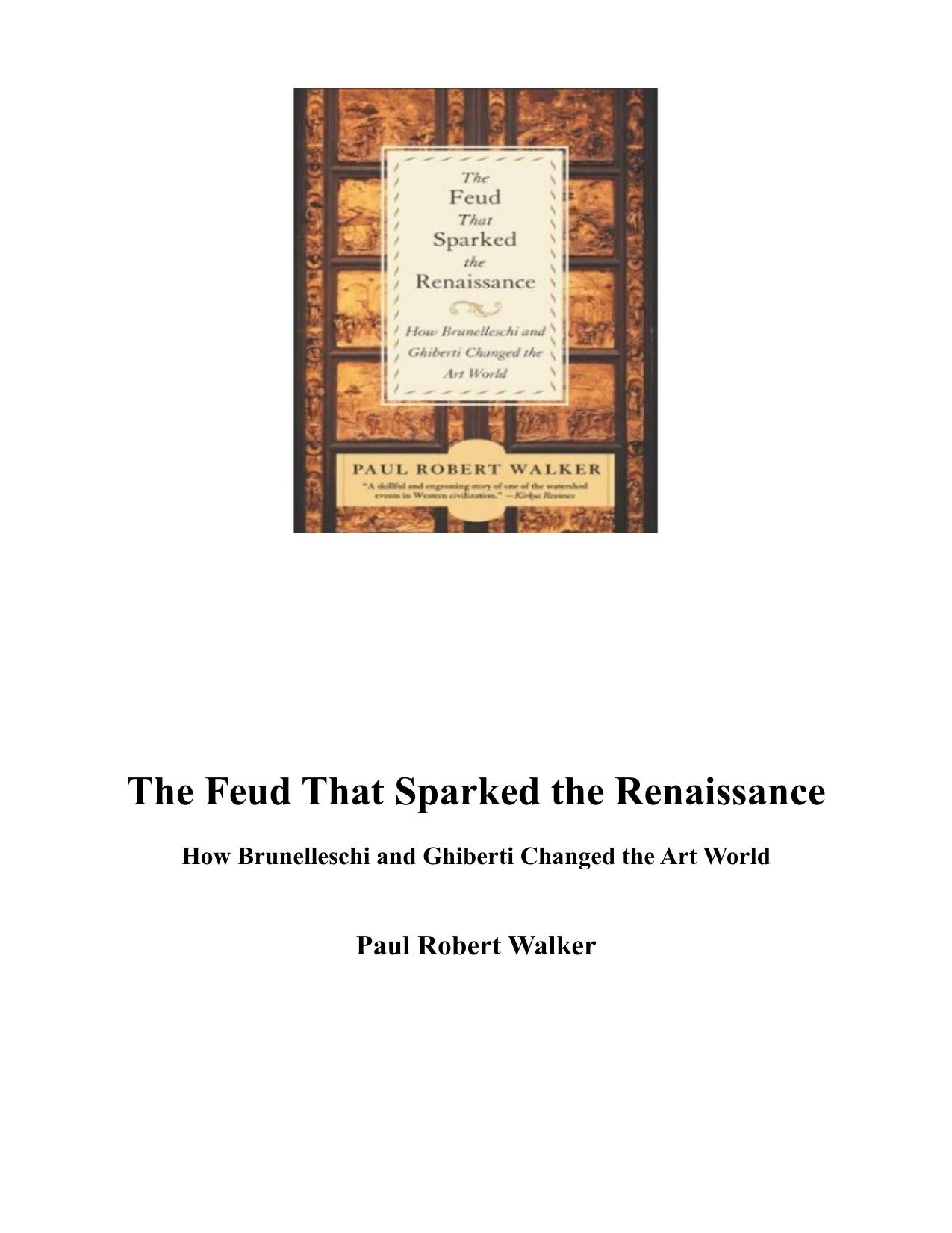The Feud That Sparked the Renaissance: How Brunelleschi and Ghiberti Changed the Art World by Paul Robert Walker

Author:Paul Robert Walker [Walker, Paul Robert]
Language: eng
Format: epub, pdf
Tags: History, Europe, Renaissance, Art, European
ISBN: 9780380807925
Google: kZf0lwEACAAJ
Publisher: HarperCollins
Published: 2003-11-24T23:00:00+00:00
Thirteen
BIG THOMAS
The appearance of a man of outstanding creative talent is very often accompanied by that of another great artist at the same time and in the same part of the world so that the two can inspire and emulate each other.
—Vasari, Lives of the Artists
ALTHOUGH THE DOME of Santa Maria del Fiore is Filippo Brunelleschi’s most famous and instantly recognizable creation, his greatest contribution to the art of the western world was the rediscovery of linear perspective. Not a single authenticated drawing in Filippo’s hand has survived, and yet the mark of that hand can be found in every realistic painting since the third decade of the Quattrocento. It is no exaggeration to say that without Brunelleschi’s formulation of perspective, there would have been no Renaissance in painting at the time and place that it occurred. And there would have been no painting Renaissance at all until someone else discovered what Filippo discovered.
In his description of Brunelleschi’s perspective panel of the Baptistery, Manetti writes, “He painted it with such care and delicacy and with such great precision…that no miniaturist could have done it better,” while of the second panel showing the Piazza Signoria he claims that though other painters tried to copy it, “none was done as well as [Filippo’s].” Even if we factor in Manetti’s hero worship, Filippo must have possessed substantial skills in the painter’s art. Yet he was never a painter professionally, and he never wanted to be a painter; nor did Donatello. Lorenzo began as a painter, but he became a goldsmith. In an artistic world where an artist’s earnings were closely related to the materials he used, painters occupied a lower rung on the economic scale than a marble sculptor, who was in turn a step below a goldsmith. The Florentines respected inspired painting, and they showered honors on Giotto in the Trecento. Yet a wealthy patron would pay a painter far less to decorate a family chapel than he would a sculptor or goldsmith.
Given this economic reality, it’s not surprising that the practical application of Brunelleschi’s experiments in perspective began with sculpture. Donatello, his old friend and pupil, was the first to apply the lessons to sculptural relief, beginning with the base of the St. George and continuing with other increasingly complex shallow reliefs such as The Feast of Herod on the baptismal font in Siena. Lorenzo, who worked on the same font, would not demonstrate a command of perspective until the mid-1430s, when Filippo’s system was finally explained to him by their mutual friend Leon Battista Alberti—yet one more indication of the ongoing conflict between the two artists and the unfortunate consequences of that conflict for Lorenzo’s art. In the rapidly developing artistic world of Florence, it was better to be Filippo’s friend than his enemy, and along with Donatello, one other friend of Filippo took these lessons and ran with them, revolutionizing western painting in the process. His name was Tommaso di Ser Giovanni Cassai, but we know him today as
Download
The Feud That Sparked the Renaissance: How Brunelleschi and Ghiberti Changed the Art World by Paul Robert Walker.pdf
This site does not store any files on its server. We only index and link to content provided by other sites. Please contact the content providers to delete copyright contents if any and email us, we'll remove relevant links or contents immediately.
| Africa | Americas |
| Arctic & Antarctica | Asia |
| Australia & Oceania | Europe |
| Middle East | Russia |
| United States | World |
| Ancient Civilizations | Military |
| Historical Study & Educational Resources |
Room 212 by Kate Stewart(5035)
The Crown by Robert Lacey(4723)
Endurance: Shackleton's Incredible Voyage by Alfred Lansing(4676)
The Iron Duke by The Iron Duke(4291)
The Rape of Nanking by Iris Chang(4137)
Joan of Arc by Mary Gordon(4013)
Killing England by Bill O'Reilly(3951)
Say Nothing by Patrick Radden Keefe(3903)
I'll Give You the Sun by Jandy Nelson(3357)
Shadow of Night by Deborah Harkness(3302)
Hitler's Monsters by Eric Kurlander(3268)
Mary, Queen of Scots, and the Murder of Lord Darnley by Alison Weir(3149)
Blood and Sand by Alex Von Tunzelmann(3138)
Darkest Hour by Anthony McCarten(3070)
Eleanor & Park by Rainbow Rowell(3063)
Margaret Thatcher: The Autobiography by Thatcher Margaret(3028)
Red Famine: Stalin's War on Ukraine by Anne Applebaum(2873)
Book of Life by Deborah Harkness(2867)
The One Memory of Flora Banks by Emily Barr(2803)
